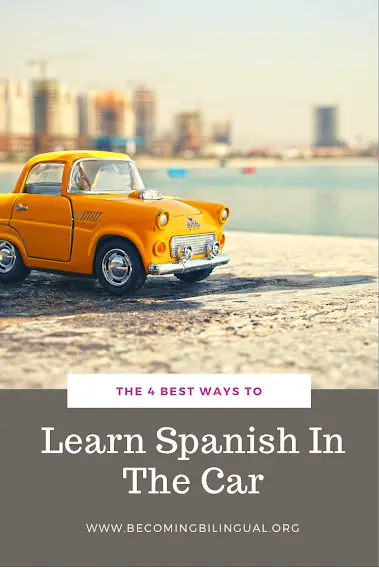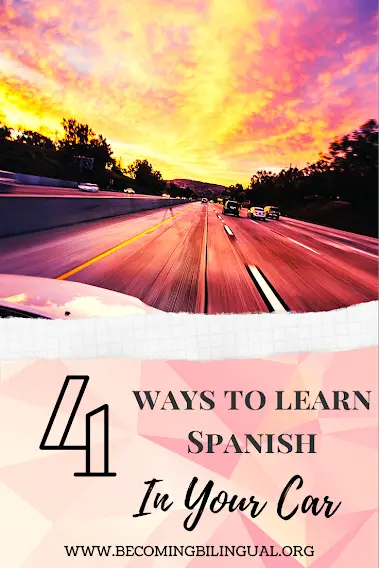The Best Way To Learn Spanish In The Car

One of the times that we practice Spanish each week is in the car. It’s a great way to practice and there are so many ways in which you can make this a passive language learning time or an interactive and conversational learning time!
If you’ve read some of my previous posts you know that I talk about driving in the car a lot. My daughter and I spend about an hour a day in the car during the work week and sometimes time on the weekend when we need to run errands.
I am my daughter’s only source of Spanish, since our community language is in English, and her school is in English. Since there is so little time for Spanish compared to her English language exposure, we need to take advantage of every single minute that we have.
Learning Spanish in the car is also a great strategy for those of you who are using the “time and place language learning method”. If there aren’t two parents to each speak a language (OPOL) or if you’re learning the target language with your child then “time and place” might be the best bet for you!
Whether you’re a beginning Spanish learner or a native speaker teaching Spanish to your children, working on Spanish language skills while you’re driving is a great way to boost your language skills and Spanish time.
Table of Contents
Top ways to learn Spanish in the car:
1. Spanish Audiobooks
Audiobooks are a great way to learn Spanish and there are more and more great options for Spanish audiobooks that are available.
When we use audiobooks, we like to listen to books on tape. That means that we actually have the physical book and we’re listening to the CD in the car.
The reason that I like this combination the best is because I can compare the pronunciation of the words that I’m hearing, to the written words in the book when I read it later at home.
It helps me to learn the way to say new Spanish words and it helps me to commit those new words to memory, because now I’ve heard them and read them.
You can also find a great selection of audiobooks that aren’t books with CDs. We have a few audiobooks that we listen to as well and they’re great for getting in some practice listening to native Spanish speakers.
Since I am also a Spanish language learner, my daughter doesn’t have much exposure to fluent and native Spanish. There are some choices on Audible and other sources like Vox.

2. Spanish Podcasts
Podcasts are another great way to get in some language learning in the car. Podcasts are different than audiobooks in a few important ways.
When someone is reading out loud, their speech is generally slower than when a person is just talking or in conversation. While audiobooks and books on tape offer great vocabulary exposure, podcasts generally offer faster and more conversational Spanish that can help with conventions and colloquial language skills.
One of our favorite podcasts for kids features a section called, “pregunta de la semana” where kids can call in and answer the question of the week. My daughter loves hearing other kids speaking in Spanish and it’s fun to listen to other types of native voices!
Podcasts can also provide a great source of information since you can often find podcasts on a specific topic that you want to learn more about. This option makes them great for learning more technological vocabulary about something that you’re interested in and allow you to increase the depth of your Spanish language skills.
3. Spanish Music
As always, Spanish music is a very common way to passively learn Spanish. One of the huge benefits of using Spanish music is that the lyrics of songs are often easy to memorize. After a few listens to a catchy song you can have a few Spanish phrases memorized and, depending on what you listen to, these can be useful phrases!
When I started listening to Spanish music in the car with my daughter, we listened to Spanish nursery rhymes about daily routines (brushing teeth, cleaning up, setting the table,etc). Then, when we actually did those activities in our house, we had grammatically correct Spanish phrases that we’d memorized from the songs so we could talk about the activity.
Another benefit to Spanish music is being able to sing along with it out loud. Singing out loud will help you to improve your pronunciation since you’re matching your voice to that of a native speaker.
It will also allow you to practice saying Spanish phrases at a faster pace than you may normally say them, helping you to build muscle memory.

4. Spanish Language Games
There are so many fun Spanish language games that you can play in the car with your family. One of our favorites is “veo veo”. “Veo Veo” is actually the name of a popular Spanish song – you can check out one version here – but it can also be used like an iSpy game.
When my daughter and I play, we start by thinking of an object/animal/or something that we see while driving and we give the first letter/sound:
Me- Veo veo! (I spy)
Daughter- Que ves? (What do you spy?)
Me- Una cosita (A little something)
Daughter – Y que cosita es? (What is it?)
Me – Empieza por la (letter or sound) (It starts with a…)
Spanish language games are great for active Spanish language learning! When you’re working on a game like ‘veo veo’, you’re also working on Spanish phonological awareness skills which can help your child to read and write in Spanish as well.
If you spend a lot of time in your car or are working on ‘time and place’ language learning, then take a look at some of the many ways you can use this time to actively boost your language skills!
Happy Learning!
Don’t forget to subscribe here to get my latest posts and resources!